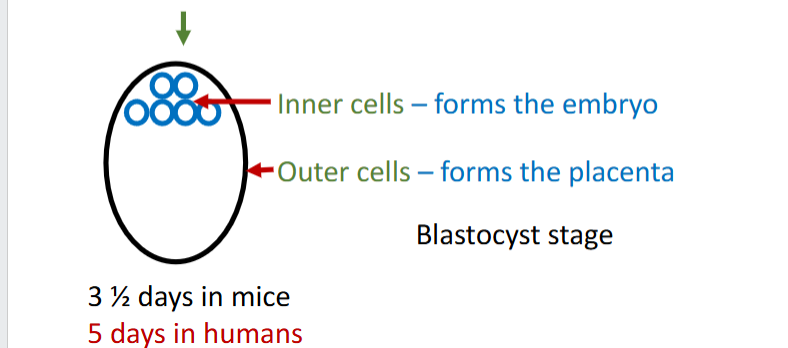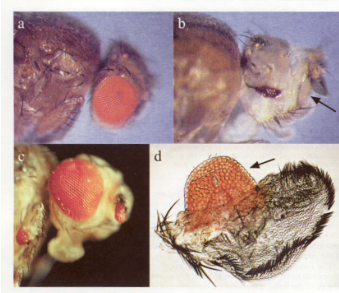human and animal development

Development of the embryo
fertilized egg - single cell
hoe does the information in the DNA generate a complex structure
gestation period (happens early in the developmental cycle)
humans = 266 days
mice = 20 days
elephants = 645 days






Later development of the embryo includes:
neurulation
formulation of spinal cord and brain (occurs after gastrulation)
organogenesis
formation of organs

Developmental problems when the neutral tube fails to close
spina bifida

Organogenesis
e.g. the mammalian forelimb

cells are directed to specialise in different ways
controlled by genes being switched on and off in different ways in different cells
epigenetics
Epigenetics
Professor Conrad Hal Waddington (1905-1975)
proposed the term in 1940
Professor Sir Adrian Bird (1977- )
discovered the molecular basis of epigenetics
genetic changes not associated with changes in the DNA sequence
genes permanently switched on/off
determines cell type



Genes involved in development
how do we know which genes are involved in controlling development
make use of mutants
drosophila (the fruit fly)
Homeotic mutants
mutants that affect development

genes which have a universal function in development
HOX genes
e.g. eyeless mutant of drosophila
Eyeless mutant
caused by a mutation in the Pax-6 gene

Human homologue of Pax-6
mutation in the Pax-6 gene causes bilateral Anopthalmia



Genetics versus the environment
nature - nurture debate
clear genetic influences
e.g. haemophilia: presence of the defective alleles causes the phenotype
clear environment influences
e.g. ricketts: vitamin D deficiency causes phenotype
genetic and environmental influences
rhesus blood group and pregnancy
blood groups Rh+ and Rh-


Genetics versus the environment
e.g. temperature sensitive genes
siamese cat
growth in a cooler environment produces a darker colour in extremities - the pigmentation gene is “switched on“ in a cooler environment
himalayan rabbit and guinea pig
measuring the effects of genetics versus the environment
keep the environment constant
e.g. plant genetics
keep the genetics constant (more difficult)
need for genetically identical individuals
inbred lines (e.g. laboratory mice)
cloning (e.g. “dolly“ the sheep)
twins
Studies on twins

Heritability
probability that shared phenotypes are NOT explained by the environment or by chance
gives an approximation of the contribution of genetics to a phenotype
e.g. a heritability score of 80% means that there is probably a significant genetic effect
can be determined by comparing phenotypes in monozygotic (MZ) and dizygotic (DZ) twins
Case study: genetics of schizophrenia
specific clinically defined category of neurodiversity
long-term condition that involves psychosis
difficulty in distinguishing own thoughts from reality
long term debate about whether this is genetically inherited (nature) or induced by the environment (nurture)
historically (up to 1970s) - thought to be related to upbringing of children
early studies 1950s - 1970s identified that it ran in families
a possible genetic influence?
twin studies demonstrated a high degree of heritability
concept of “genetic susceptibility“
other factors affect it, but only individuals that are genetically susceptible
2017 Danish twin study (Hilker et al 2017)
Danish twin register - started in 1954 and includes twins born from 1970 onwards
complete records for all Danish-born twins born from 1968
Danish Psychiatric Central Research Register - all psychiatric admissions since 1969
31,524 twin pairs
2017 Danish twins study
estimated the heritability as 79%
major genetic component
Other factors involved
upbringing but only if genetically susceptible
more schizophrenic individuals born in winter rather than summer- linked to influenza epidemics
infectious agents- the parasite toxoplasma gondii
development errors in the brain of the brain (non-genetic)
dietary- deficiency of essential fatty acids
both nature and nurture contribute
Case study: Genetics of intelligence
need a standardized measure of intelligence
intelligence quotient (IQ)
but does not measure all forms of intelligence
however, a strong correlation between IQ and success at school
twin studies show a heritability of around 50%
moderate influence of genetics
25% comes from the shared environment for the twins
25% from their unique environment
heritability increases with age (less than 40% at age 9 but as high as 80% beyond age 20)
suggests that the environmental effects are more significant earlier in life
 Knowt
Knowt